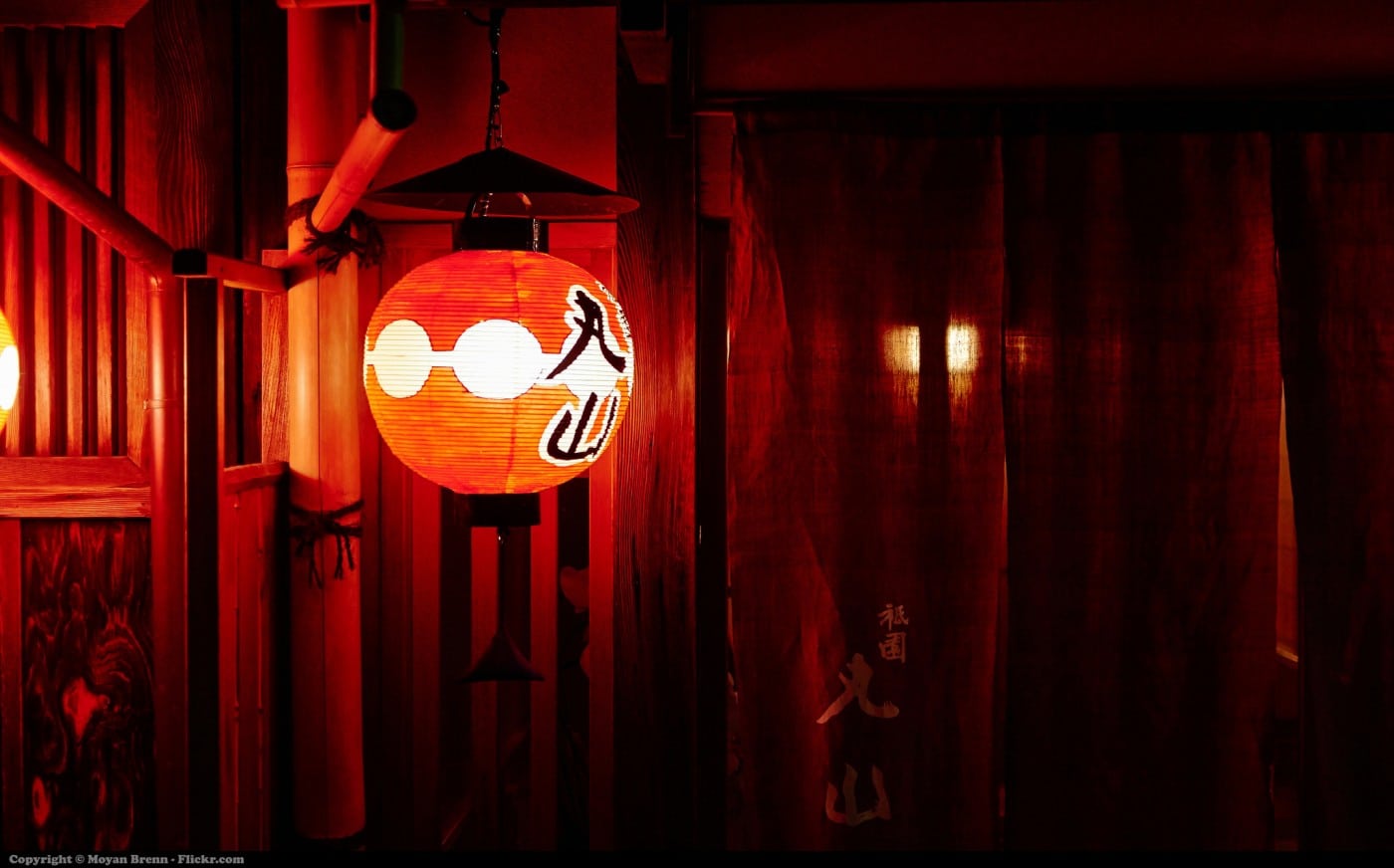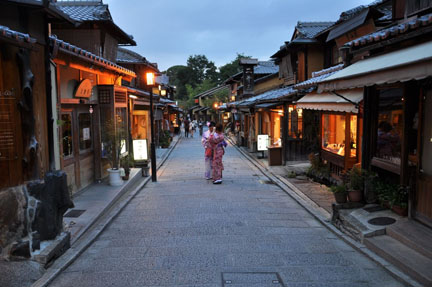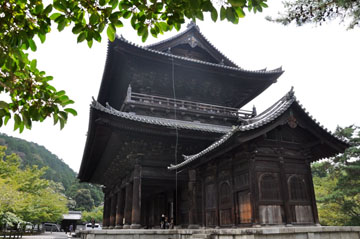I considered Kyoto a one-day trip, planned to visit for two, and in the end stayed for three. The truth is though you could easily spend a week in this city three hundred miles southwest of Tokyo. Kyoto is a fishbowl city, nestled in mountains on its West, North and East sides, but in fact it’s no small town. It feels more like the Chicago of Japan—smaller than Tokyo but with plenty of towering buildings and wide city streets. It is by no means quaint yet it has a special tranquility that almost feels as if it is steeped in antiquity. In two and a half days, my husband and I toured three major areas so if you only have enough time for a side trip, here’s how to do it.
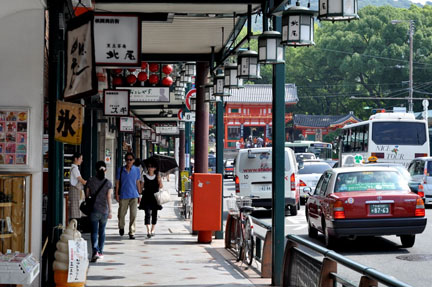
DAY ONE PM: DOWNTOWN KYOTO
After a two hours plus morning ride beside picturesque mountains and rice paddies on the bullet train from Tokyo (the Shinkansen, about $150 per person one way), we arrived at Kyoto Station. We had prepared ahead researching the various traditions for visiting Buddhist temples and Shinto shrines, and I’d suggest this so you’ll be better acquainted with the customs – purifying your hands in the fountains, pulling on the fat ropes that sound the prayer gong, buying emas (wooden plaques) to write and hang your wishes, lighting ceremonial incense, and pulling fortune sticks for your future.
From the station in downtown Kyoto, we took the subway north along the Karasuma line to drop our bags at the Hotel Monterey, just south of Sanjo-Dori (dori means street). Worth noting: The subways are clean and easy to navigate but cover only a small area; you’ll either want to take (the very cheap but very slow) buses or our personal preference – affordable and fairly quick taxis. From here, we wandered east down Nishikikoji-dori, which turns into the Nishiki Market. The market, which is arranged on long, wide tented streets is a vibrant and colorful place of vendors selling fish arranged like art, edamame bunches still on their stalks, pickled vegetables and candies and gifts. From here, we wandered up and down the streets, observing the architecture of the michaya-style traditional wooden townhouses where locals and tourists were riding bicycles. Worth investigating: Some hotels may offer bikes to borrow or rent; if I ever go back I’d love to tour more of the east side this way.
When night fell, we hit the city’s former red light district, Pontocho, which lies just west of the Kamo-gawa River. Pontocho Street is a narrow, charming street that comes alive at night with glowing lanterns hanging along the time-honored wooden exteriors and brightly lit signs hanging just above head height. The restaurants run the gamut from reasonable to very expensive and are worth trying, though we opted for a small, noodle shop nearby. After dinner, we wandered east on Shijo-dori crossing the bridge over the Kamo-gawa river which divides downtown from Higashiyama (the East Mountains). Just across the water sits the gorgeous Minami-za Kabuki theater building. And Memoirs of a Geisha fans will want to head toward the corner of Shijo-Dori and Hanamikoji-Dori to see the Ichiriki Teahouse which played a big role in the novel. (I think it’s worth a mention that tourists often enjoy visiting places they’ve seen on T.V. or in the movies because it’s familiar and there’s something special about standing on the spot where your favorite movie scene took place). Evening bonus: This is the best area to spot a geisha (the local term is geiko) entertainer. We saw our first around 11 p.m., wooden box in hand and walking with a Japanese man in a kimono.
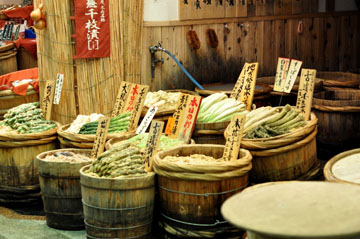
DAY TWO: HIGASHIYAMA (The East Mountains)
NORTHERN HIGASHIYAMA
Next morning we took a taxi to the quiet temples at the base of the Higashiyama Mountains (a 10 minute ride for about $12). Our first stop was the Nanzenji Temple, a massive dark wood Buddhist temple rebuilt in the 17th century that was gorgeously, ceremoniously old. In fact, as we passed Japanese maples and turned the corner to view the San-Mon gate for the first time, it brought out a very un-Zen “Holy [bleep]!” moment in me. Our hearts beat faster in the sight of beauty this awe inspiring. We later learned that Scarlett Johanssen’s character in Lost in Translation had visited this very spot. It’s free to tour the main temple (for an additional $4, you can visit the second floor). What I wish we’d done: You can also walk up behind the temple through gardens, along an aqueduct, across a koi pond, and into the woods to a waterfall at the base of the mountains.
Besides this temple, there are numerous others dotting the streets and while we enjoyed getting lost among them, we asked for directions to find our way to The Path of Philosophy. This quiet, tree-covered path, running just over a mile along a canal dotted with walking bridges, has benches for contemplation and is named after Japanese philosopher Nishida Kitaro, who used to stroll it deep in thought. Going in April? It’s said to be the most beautiful (though most crowded) when the cherry trees are in bloom.
At the northern end of the path sits a touristy road leading up to the Ginkaku-ji temple, the “Silver Pavilion” (about $7 to enter). Inside the simple gate is a garden path that passes through the grounds, past some incredible art of raked sand called kogetsudai and up a hill where you can view downtown Kyoto. The temple itself is so superbly simple that we weren’t sure which building it was. The downside was the crowds inching us along like cattle making it difficult to feel much tranquility. Worth considering instead: A ten-minute walk south to the more out-of-the-way 17th century temple Honen-In, which is set back in the woods and is said to be a true respite of quiet and calm. Another option is the sister shrine Kinkaku-ji, the Golden Pavilion. The trip there requires a taxi ride to Northwest Kyoto and while it’s bound to be equally teeming with tourists, the shining golden temple surrounded by water is said to be a show-stopper.
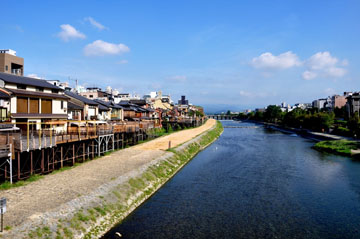
SOUTHERN HIGASHIYAMA & GION
We began our tour of Southern Higashiyama at the Yasaka Shrine, which sits proudly at the east end of Shijo-Dori. The shrine, which is considered the “guardian shrine of Gion” is a two-story bright orange and white pagoda that pops from the green pine trees and bright hills behind. It’s a definite Kodak moment. Admission is free, so it’s worth a stroll inside the gate.
From here, we headed south into the small streets of Gion the main setting of Memoirs of a Geisha. And my goodness, it’s no wonder. The stone streets are adoringly quaint, and lined with one or two-story wooden buildings with ornamental roofs. Around one corner we found a rickshaw driver walking tourists by foot; around another, the five-story Yasaka pagoda rising above the skyline, as the beautiful sounds of chanting monks floated into the street.
Our last site for the day—and an absolute must-see—is the complex of the Kiyomizu-Dera Temple. The entrance looked like Kyoto’s version of Rome’s Spanish Steps and at the top sat two stunningly colored structures painted orange, red, pink and green, with an array of smaller buildings clustered behind them. The view of the city from the top of the steps is jaw-dropping, especially at sunset. Though it’s crowded enough to feel like a Disney attraction, you can easily spend two hours touring all the structures, as well as the main hall that’s perched on a wooden platform on stilts dug into the hill. A must-do: Descend the steps from the main hall to the Otowa-no-taki spring, and line up for an opportunity to drink from the sacred waters, said to have therapeutic properties.
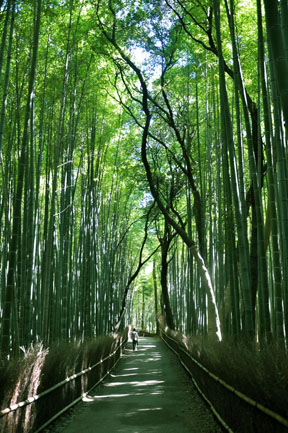
DAY THREE: ARASHIYAMA (The West Mountains)
We traveled to the West of Kyoto by subway (with green velvet upholstered seats!) and got off at the Arashiyama station at the edge of the Hozu-gawa River. Crossing the Togetsu-Kyo bridge invited new views of Kyoto that reminded me of the Japan I’d seen in guidebooks, like the photo of boats powered by men wielding bamboo poles in the water.
From here, we walked north to the Bamboo Forest. Though just a small path, the towering green bamboo plants there are a wonder of nature. To reach it, we paid to enter the Tenru-ji Temple (about $8) which opens to the forest, but you can also walk around the temple and turn onto the path just past the North Gate of Tenru-ji. The deeper you head away toward the hills, the more lush and stunning the bamboo becomes.
Our next stop was Arashiyama Monkey Mountain (about $8), which earned a spot on both our “They’d never let you do this in America” list and on our “One of the best things we’ve ever done” list. A short 20-minute hike up a steep hill delivers both a stunning view of Kyoto and about one hundred and fifty red-faced snow monkeys freely scurrying along the dirt grounds. It feels like you’ve stepped into the pages of National Geographic as you walk among them while they play, snack and nap. You can also enter the caged area to feed them bags of apples and peanuts, which we loved.
Our final stop in Kyoto was the Saiho-ji Temple (also called the Moss Temple), a taxi ride away, which we had reserved a month prior. Important: You must make reservations for this temple by sending them a self-addressed request letter (Google the details you must include and the address of where to send it.) Considering that most Kyoto temples are free, the $30 entrance fee is steep, but it was both a beautiful sight and an oddly unique experience. Upon entering the grounds with our invite, we were ushered to the main pagoda where we removed our shoes and sat Indian-style at a small wooden desk with about one hundred other guests, all of us facing the room’s central shrine where three monks in orange robes drummed and chanted. We were provided with brushes and ink to copy an entire prayer in Japanese kanji characters along with our own wish. “Wait,” my husband said, “Are we supposed to do homework right now?” We finished copying it in about forty-five minutes, added our wishes as instructed and presented them at the shrine. Afterward, the tour among the moss garden was breathtaking – an entire garden of trees and walking bridges covered in layers of different colored greens. It was the perfect ending to what seemed to me like my very own quiet, reflective Japanese dream.
Country Code for Japan (Kyoto) is (+81)
[alert type=white]
WHERE TO STAY
Hotel Monterey– Located in central Downtown, this cozy upscale spot is a great home base to see a unique blend of European and Japanese culture. The European style décor, complimentary high-speed internet access and mini-bars, makes this hotel well worth the stay. Rates average $150-$300 per night. 3 Jyo Minami Karasuma-dori Nakagyo-ku Kyoto, Kyoto-fu, Japan, 604-8161. Tel: 81-752517111; www.hotelmonterey.co.jp
The Westin Miyako Kyoto– This five-star hotel is the perfect spot to set out by foot to see Northern Higashiyama. Located on the corner of two main roads at the base of the hills, the high-floor rooms offer a spectacular view. Rates average $150-$250 per night. Sanjo, Keage, Higashiyama-ku, Kyoto, 605-0052, Japan. Tel: (81) (75) 771-7111; www.starwoodhotels.com/westin
Motonogo Ryokan– For a unique sleeping experience, consider booking one night in a ryokan, a traditional Japanese Inn. Ryokans tend to be pricier than other hotels, but they definitely offer a traditional Japanese experience like no other. Each offer Japanese-style rooms, covered in tatami floor mats with sliding doors. Instead of a mattress, guests sleep on a soft futon on the floor, and have the option to include a multi-course kaiseki dinner served by staff members in kimonos, for about $60 per person. Rates average $250- $600 per night. 511 Washio-cho, Kodaiji-michi, Higashiyama-ku, Kyoto City Tel: +81-75-561-2087; www.motonago.com
Gion Machiya– This vacation rental townhouse also offers a unique cultural experience, located adjacent to the Gion Geisha district and along the road leading to Kiyomizu Temple. Japanese calligraphy and pottery classes are available for you artistic types. You can also expect tatami mats in the rooms, like the ryokans. 157-5 Tamoncho, Higashiyamaku, Kyoto, Prefecture 605-0844, Japan. www.gionmachiya.com
WHERE TO EAT
Takaraya Sumashi Ramen- This ramen shop at the north end of Pontocho street serves what’s been called “nouveau” ramen, garnished with mozzarella cheese and bacon, as well as your gotta-have-‘em pork gyoza. Meals average $25. 122-5 Ishiya-cho, Pontocho, Nakagyo-ku, Kyoto; Tel: + 81 75-222-2778; www.takaraya.info/shops
Issian Pontocho– This Pontocho gem serves hot-stone grilled food—in which your meal is cooked on a stone from Mount Fuji in front of you at the bar. The set meal averages $40 a person. 178-3 Zaimokucho, Higashikiyacho Sanjo Kudaru, Nakagyo-ku | Pontocho Hidaka Building 1F, Kyoto Prefecture 604-8017; Tel: +81 75-254-8568
Ichi Ban– This restaurant is rife with a lively ambiance, thanks to the wooden architecture and smoking grills that cook the yakitori (chicken, beef, fish and vegetables on skewers). Thankfully, they have english menus so you can make sure you know exactly what your ordering. Meals average $40-$50. Sanjo Ohashi, 2-80 Higashiyama-ku, Kyoto, 605-0001. Tel: + 81 075 751-1459
MUST SEE
Pontocho– This area is named after Pontocho-street that runs about ten blocks west of the Kamo-gawa river. Most restaurants on the river side have outdoor seating over platforms on stilts, jutting out over the water. If you are not interested in grabbing a bite with the locals, a pleasant evening stroll up and down the street is still worth the visit.
Kiyomizu Dera or Nanzen-ji– A visit to Kyoto is not complete without stopping at a jaw-dropping temple you can only find here. I’m torn between two of my favorites from our trip. If you like waterfalls and the view of cherry and maple trees, you need to see the Kiyomizu-Dera temple in Gion. For those who want to escape the crowds, visit the serene Nanzen-Ji.
Iwatayama Monkey Park– (Entrance fee is around $8) It’s a fun and highly interactive experience to walk among the snow monkeys as they meander through their natural environment. Plus, the view from the top of the hill is the most beautiful sight we witnessed of all of Kyoto.
[/alert]

